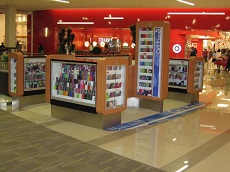
The goal of merchandising should be to attract the interest of customers. Its whole purpose is to make your store stand out and, honestly, look beautiful. It’s about creating a welcoming characterful environment. It’s gotta be somewhere that customers find appealing, and at the same time, they have to be able to find what they want.
Doing it right is tough indeed. So here are some pro tips that will get the products flying off the shelves.
- Add Words to Displays
- Use Cardboard Displays
- Rotate Displays
- Bring in the Props
- Focus on What Customers Want, Not What They Need
- Group Items
Often displays can be quite bland affairs. There isn’t much of interest besides the product itself. But a few select words can make a lot of difference. They’re like a prompt that gets the customer to imagine how they might benefit from the product. Often customers struggle to think about how they might use a particular product. And this can mean that they rarely branch out and try new things. In other words, it’s a way of driving demand.
Cardboard displays are an excellent way to get products right under the noses of customers. And because they can be temporarily erected, they’re extremely versatile.
Many shops use cardboard displays for sale items that need shifting fast. But they’re also a great place to put things like candy, for impulse purchases at the checkout.
After a few weeks with the same layout, you shop floor can start to feel a bit stale. That’s why it’s a very good idea to consider rotating displays. Switching up the stock at the front of the store with new merchandise can give your store a fresh appeal. And it’s a great way to get customers immediately engaged with any new products.
Having props that are unrelated to your products in product displays is a little bit like adding words to displays. It is just a little something that helps to complete the picture. Lines of products in a row often doesn’t feel natural, and so there needs to be something that humanizes the experience.
For example, if your store sells clothes, think about adding mannequins to displays. Once the human figure is in the display, adorn their surroundings with seasonal features. Perhaps you could add bright pot plants in the summer or nativity themes in the winter.
If a customer needs one of your products, they’re going to buy it anyway. That means there isn’t any reason to make things like lightbulbs and batteries into big displays.
Displays, rather, should be reserved for the things that people want. The point of merchandising should be to create an additional desire in your customers, beyond that which they already had. You could have a display of luxury champagne, for example. Or you could have a display dedicated to your finest designer clothing.
Displays shouldn’t be entirely uniform. But neither should they be disorderly. Most merchandisers find that they have the most success when products are grouped by type. You could have an area for all things ski-related, for example.







Thanks for this informative article. I agree that rotating the displays every so often can help the store have a fresh appeal. I would imagine that this would be good to do when a new product comes around or when sales are low. Perhaps one way to remember to do this is have a set day each month that you will move around the displays.